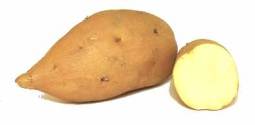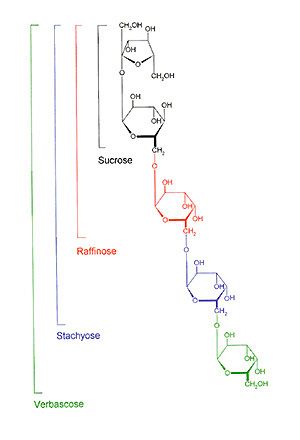|
|||||
|
|||||||
|




An initiative of :

|
| Food-Info.net> Food Products > Tropical roots and tubers Sweet potatoAgronomic CharacteristicsSweet potatoes require a well-drained soil and grow best in a warm growing season. Optimum moisture requirements are about 76-127 cm of rain per year. This is slightly lower than most of theother root and tuber crops, and once the plants are established, they can tolerate drought moderately well. A relatively short growing season of 3-6 months is needed for maturing.  Antinutritional FactorsSweet potato contains raffinose, one of the sugars responsible for flatulence. Three of the sugars which occur in plant tissues, raffinose, stachyose and verbascose are not digested in the upper digestive tract, and so are fermented by colon bacteria to yield the flatus gases, hydrogen and carbon dioxide. The level of raffinose present depends on the cultivar. In some parts of Africa the cultivars used are considered too sweet and cause flatulence. It has been established that sweet potato shows trypsin inhibitor activity (TIA) ranging from 90% inhibition in some varieties to 20% in others. There is a significant correlation between the trypsin inhibitor content and the protein content of the sweet potato variety. Heating to 90°C for several minutes inactivates trypsin inhibitors  raffinose and stachyose In response to injury, or exposure to infectious agents, in reaction to physiological stimulation or on exposure of wounded tissue to fungal contamination, sweet potato will produce certain metabolites. Some of these compounds, especially the furano-terpenoids are known to be toxic. Fungal contamination of sweet potato tubers by Ceratocystis fimbriata and several Fusarium species leads to the production of ipomeamarone, a hepatoxin, while other metabolites like 4-ipomeanol are pulmonary toxins. Baking destroys only 40% of these toxins. Utilisation and ProcessingSweet potato can also be eaten boiled, fried or roasted. When sliced, dried in the sun and ground, it gives a flour that remains in good condition for a long time. In Indonesia, sweet potato is soaked in salt water for about an hour to inhibit microbial growth before drying. The flour is used as a dough conditioner in bread manufacturing and as a stabiliser in the ice-cream industry. Sweet potato has been processed into chips (crisps) in much the same way as potato and the product is now popular in Asia. The sugar-coated chips are popular in China, the sailed variety is popular in the United States of America, while those spiced with cayenne pepper and citric acid have been tested in Bangladesh with favourable results. Starch is produced from sweet potato in much the same way as from the other starchy roots except that the solution is kept alkaline (pH 8.6) by using lime, which helps to flocculate impurities and dissolve the pigments. The starch shows properties intermediate between potato starch and corn/cassava starch in terms of viscosity and other characteristics. In Japan about 90% of the starch produced from sweet potato is used in the manufacture of starch syrup, glucose and isomerised glucose syrup, lactic acid beverages, bread as well as other products in the food industry. In Japan, sweet potato starch is also used for the production of distilled spirits called shochu . The process is very similar to that of whisky production except that the koji , equivalent to the malt starter in whisky production, is obtained by inoculating steamed rice soaked in water overnight with Aspergillus kawachii for two days at 35 to 37°C. The koji is mixed with starch water and yeast to promote saccharification and fermentation. The filtrate is finally distilled. Cassava, cocoyam and yam also contain phytate. Processing into fermented foods will reduce the phylate level of root crops sufficiently to nullify its adverse effect. The loss of phytate during fermentation is due to the enzyme phytase, naturally present in the tubers or secreted by fermentative microorganisms. Oven drying has only a small reductive effect on the phytate content compared with fermentation. Cooking also has a significant effect. |
||
| Food-Info.net is an initiative of Stichting Food-Info, The Netherlands | ||||